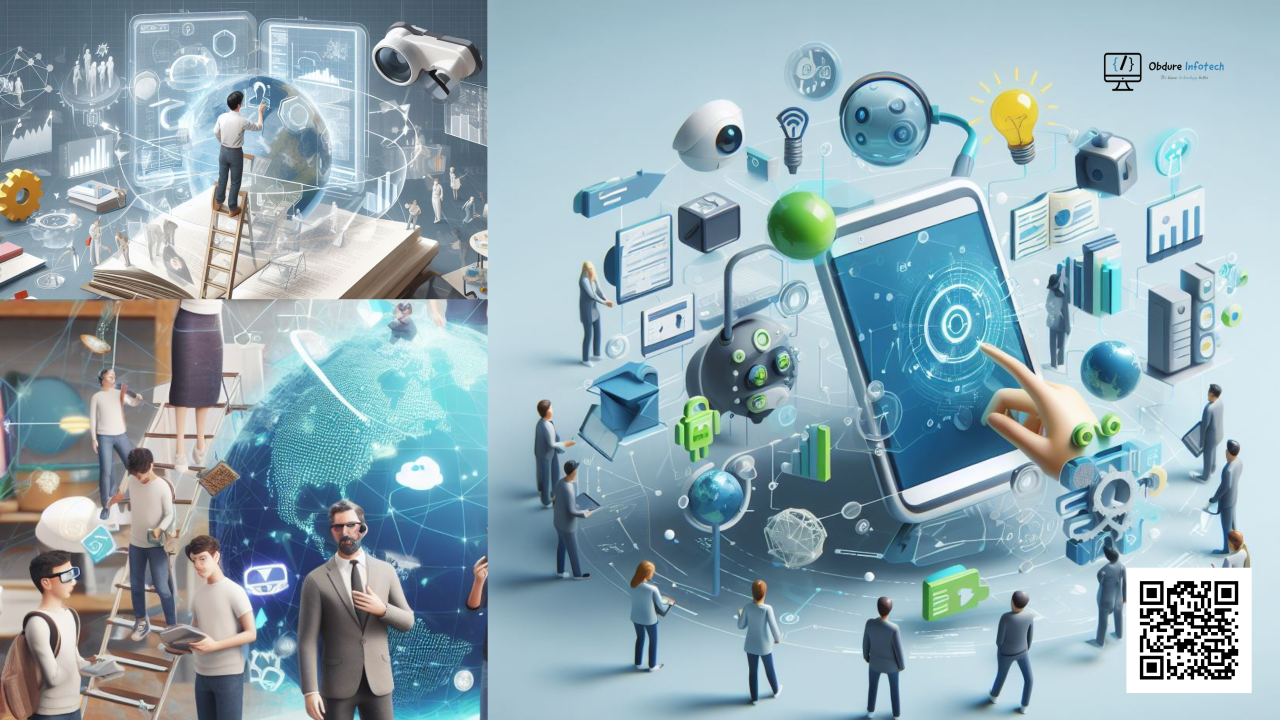Cost-Benefit Analysis of Implementing AR in Manufacturing Training Programs

One of the primary applications of augmented reality (AR) is in the training of manufacturing workers. It uses technology to overlay digital information on the real world, offering multiple course for the learners to test themselves. In the manufacturing industries, AR can assist the workers to understand the functioning of the machinery appropriately as well as carry out tasks and follow safety procedures with ease.
The costs, and benefits, of investing in AR: This analysis is a cost-benefit analysis and shows the benefits and financial impact of AR technology within the business of manufacturing training. This blog is a comprehensive introduction guide for any manufacturer seeking answers to how much AR would cost for them and why it enables them to make those informed decisions about AR should be an ideal choice for the training requirements for their company.
Description: Initial costs for AR headsets, glasses and related hardwaremiddleware
Use Case: Factory to invest in AR glasses so workers can learn to operate complex machinery from augmented instructions. While costing a few hundred to even a few thousand dollars each depending on options
Description: Costs associated with the creation of bespoke AR training modules or the purchase of commercial AR software.
Use Case: A manufacturing company building specific augmented-reality based training modules for its machinery/process. The cost of paying a software developer or for a software license can easily be in the thousands to tens of thousands of dollars
Description: Employing IT consultants for incorporating AR training modules with the company's LMS Its integrated to assure that AR training data is in sync with other training records and analytics
Use Case: Hiring IT consultants to integrate AR training modules with the company’s existing Learning Management System (LMS). This integration ensures that AR training data is synchronized with other training records and analytics (The SOLIDWORKS Blog).
Description: Training Costs for Upgrading AR Tools and Transition Management costs EditingController
Use Case: Interactive workshops for trainers to get hands-on experience of the new AR technology in training applications. Such expenses include trainer fees, training materials and employee time spent on training sessions.
Description: The security, maintenance, and overall operability of AR hardware and software must be maintained through regular care, as well as occasional enhancement.
Use Case: Plant schedules regular maintenance for its AR headsets/ updating AR training software. This even accounts for maintenance personnel, spare parts, and software update subscriptions.
Description: The creation of AR training content, and updates to that content as manufacturing processes change.
Use Case: Hiring instructional designers to create more AR training modules or to update current modules based on new machinery or process changes.
Description: Augmented reality offers the next layer of learning -- interactive, hands-on training where trainees can actually interact with digital overlays in the real world.
Use Case: A trainee working on an engine can have step-by-step guides and animated flash messages on the physical engine itself which leads to enhanced skill retention as well as reduced error rates
Description: AR-based interaction for better training sessions
Use Case: Trainees interact with virtual components and get feedback during real-time training sessions. A future technician can learn how to repair a machine, observe virtual tools and parts, practice the repair and assess their performance right away.
Description: As in the automotive industry, AR/VR in remote training simulate hazardous task so that workers can understand and practice the tasks (as they should be doing) in a very safe virtual environment and very fewer chances of accidents happening IRL.
Use Case: Trainees practice managing high-risk scenarios -- like chemical spills -- in augmented reality, without being put in danger. For instance, a worker might be trained on spill handling procedure via virtual simulations, making him ready for the worst in real life
Description: AR helps in reducing the on job training enabling workers to practice in the controlled environment before getting exposed to the work which might be life threatening.
Use Case: new employees can practice operating the machines in AR before utilizing real equipment. One example is a forklift operator who can practice behind an AR headset what steering that forklift is like and how to safely use it, before actively using a real-life forklift on the factory floor
Description: Save time on trainingThe most obvious benefit of using AR to train employees is that it speeds up the training process, helping employees get up to speed quickly.
Use Case: By employing AR modules, a company decreases its training program from several weeks to days. For example, imagine a new hire is trained on an AR simulation that simulates a series of steps in a production process, dramatically cutting down the time it takes to onboard employees
Description: AR shrinks the requirement for special training facilities and also physical training components, saving money.
Use Case: Cost-savings on materials (handbooks and physical training stations, Video training) For instance, a firm does not have to create multiple training rigs and consumables to practise, as it is possible to simulate anything in AR.
Description: AR training solutions have the potential to scale up very affordably for many workers.
Use Case: A company is able to scale up its training program for new hires quickly as it grows by deploying more AR headsets. For example, during a hiring spike, the company can provide more people with AR devices to train without the need for additional physical trainers or rooms
Description: Remote training AR is a helpful attribute especially in times of a luggage ban/on the go or a geographically distributed team.
Use Case: Remote workers join AR training sessions from multiple locations, maintaining the same high-quality training. Autonomous your assignment today Wireless In particular, a worldwide corporate that is education workers in diverse countries using the identical AR modules so all of us will get high-end education.
Description: Headsets and Glasses (Equipment may have limited battery life, comfort over extended periods of use, fragile)
Use Case: a factory whose training occurs with workers wearing AR headsets, the problem is that the devices are very uncomfortable to wear for a long time, and the training system stops working due to the needs of constant recharging of devices. Also, some headsets are fragile and readily break in a factory.
Solution: Choose good, robust AR devices with longer battery life and better ergonomics and be prepared for planned maintenance and replacement Automate this article!
Description: Connecting AR software with enterprise IT systems can be complicated if AR software installed on current infrastructure is not compliant with the company.
Use Case: Manufacturing plant is struggling with moving AR training modules into their current Learning Management System (LMS) due to data synchronization problems and inefficiencies in the operation Use Case
Solution: Ensure compatibility with AR solutions supporting standard protocols and collaborate with IT specialists to facilitate integration
Description: Employees may not always be willing to adapt to new AR technologies, especially if they are used to traditional training methods.
Use Case: at a manufacturing plant, we find that our workers are feeling resistant to using AR headsets for training, as they have used the same techniques for many years and want to keep them.
Solution: Implementing methods of managing change at every level, offering extensive training, and making sure to sell the value of AR so people adopt it
Description: Employees need to develop AR capabilities, and this can take time initially, delaying the training process.
Use Case: New trainees find it hard to navigate AR interfaces and end up getting frustrated impacting the overall training efficacy.
Solution: Keep training and practice with save confidence and competence reinforced with comfortable apps and user interfaces for AR
Description: One of the challenges that businesses face when implementing an AR system is the creation of upfront costs for AR hardware, software development and system integration, which may break the bank.
Use Case: A small factory, wants to try out AR but is afraid to spend so much on headsets and creating custom training developments.
Solution: You want the process to move faster, so faster inputs will speed things up, but time saved translates to money saved down the line where returns can be significantly higher than implementation costs
Description: AR hardware comes expensive with additional costs for hardware maintenance, software updates and content development making them hard to maintain.
Use Case: A business has to constantly maintain and update their AR headsets and the training contents to make them relevant with new processes coming in place.
Solution: Plan for regular updates and maintenance in your budget to ensure that the system continues to work, and plan for long term cost management.
Description: An AI-based AR training module that automatically adjusts the difficulty of a task based on the trainee.
Use Case: A factory that is using AR for supporting all of the worker in assembly and manufacturing, to see if they have set up the equipment or the machinery the proper way or not. In the meantime, if a worker struggles on a particular task, the system will offer them more practice and tips specific to them.
Predictive Analytics
Description: AI analyses AR training data to anticipate where skills are going to be soft, thus allowing for more individualised training.
Use Case: An automotive manufacturer with AR training modules analyzes the data using AI to pinpoint what areas people performing a specific job are messing up on, and adjusts the next round of training so that people make fewer mistakes and are more competent moving forward.
Description: AR hardware advancements will bring about lighter headsets making the user experience more enjoyable and limiting fatigue during long training sessions.
Use Case: Factory installs new AR headsets with high ergonomics and usability, workers wear the AR headsets for longer periods without any discomfort and with very effective training sessions
Description: Next-gen AR peripherals with better visuals, resolution and interactivity to create more engaging and realistic training sessions.
Use Case: Electronics manufacturer applies the newest AR headsets with high-definition screens and advanced interactivity to enable trainees master complex assembly tasks with more accuracy and realism
Description: The proliferation of low-cost and accessible AR tech will see AR expanding to additional industries for training applications.
Use Case: Companies from a variety of manufacturing industries, such as aerospace, pharmaceuticals, and consumer goods, are beginning to use AR in their training programs, and see the benefits of this across the board
Description: Standardized AR training modules for frequent manufacturing tasks will pave the way for faster adoption and uptake.
Use Case: A group of manufacturers come together to build common ARP training modules for introductory operations on machinery enabling mass penetration of smaller manufacturers without the overhead of custom content development.
Augmented Reality (AR) technology has become a new trend in training in general and manufacturing, in particular while offering a lot of benefits. It enhances learning and retention by facilitating interactive, immersive experiences. Augmented reality (AR) can improve safety by using it to train workers on how to correctly carry out high-risk tasks in a virtual setting.

For modern telecom enterprises, delivering exceptional QoS is no longer optional—it’s a brand differentiator and a strategic lever for growth. Static provisioning models won’t cut it in a world of hyper-dynamic data usage.